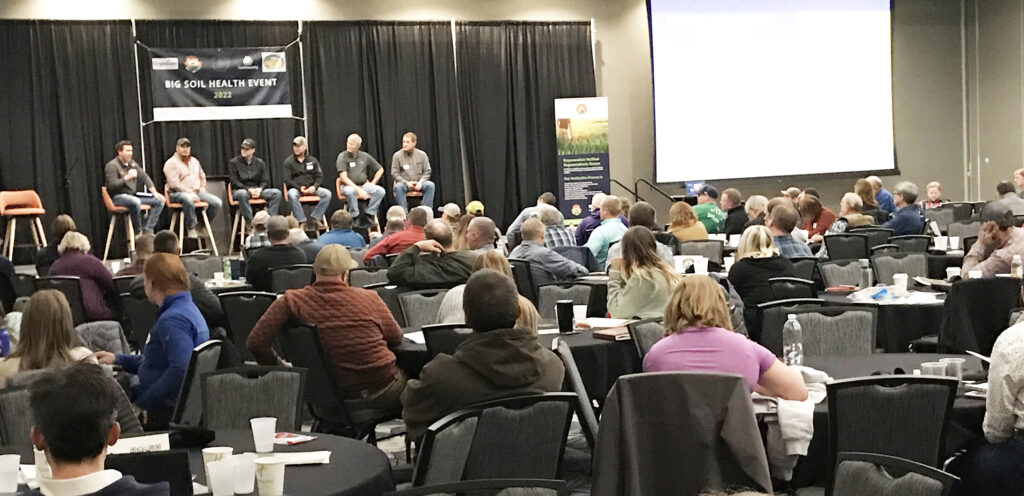Enthusiasm! Optimism! That’s the atmosphere I sensed among the crowds of farmers learning how to use more nature and less NPK at the 2022 Big Soil Event here in Cedar Falls, Iowa today.
Most of the speakers were farmers sharing how they’re enriching their soil—and their profits—with rotations, cover crops, and a huge array of biologically based products. All these innovators use the newest lab testing and GPS technology to measure soil vitality and yields. Here are some examples:
- By investing $800 in Haney soil tests to measure his soil’s biological activity, one grower cut his fertilizer bill in 2022 by $164,455 compared to the NPK levels he had applied based on conventional soil tests. “A biologically active soil releases the huge storehouse of mineral nutrients locked in the soil.” he said. That allowed him to raise 258-bu. corn this season with only 80 units of applied nitrogen.
- Several growers report “building a team” of biologically-alert farmers to share experience along their learning curve. The regularly attend conferences like this one to meet other open-minded innovators. In their own neighborhoods, they’re often seen as slightly weird to be brewing compost tea or foliar-applying $20 an acre worth of micronutrients like boron, molybdenum and nickel sulfate.
- North Carolina grower Russell Hedrick joked about neighbors’ raised eyebrows at his foliar-feeding up to two quarts per acre of SoySauce, a brand name for a blend of 5-0-12 plus micronutrients, fulvic acid and humic acid. He buys it by the 300-gallon tote. Even more exceptional, he foliar feeds in the cool of North Carolina nights, from 9:30 p.m. to 4 a.m. Of course, that calls for your own sprayer and your own family or staff… not the local co-op.
- Hedrick also applies sugar with foliars. It’s a nutrient for beneficial microbes and helps build brix levels—sugar and dissolved solids—in plant tissue. Lifting leaf brix levels to 14 or above constrains insect feeding, so you can reduce or totally avoid insecticides.
- Several growers brew their own “compost tea” on the farm, and share their microbe-rich elixirs with other biologically-based colleagues. This bypasses buying “bugs in a jug” and assures lots of live organisms in the liquid blend applied in-furrow. Benefits “won’t happen overnight,” several speakers cautioned. But over several seasons, benefits build. With several seasons of compost extract, one soybean grower counted as many as 1,000 pods on one plant. He added that weed pressure declined as soil biological life multiplied: “I cut my herbicide cost 50%. Don’t need postmerge applications.”
- Most of these growers use sap tests routinely. “It’s like a blood test for your crop,” one said. You gain two weeks’ advantage over tissue tests when you need to correct a hidden mineral deficiency.
- Several biologically-focused growers are bringing livestock back into their enterprises, including cattle which graze stubble and cover crops.
- One of the key conference organizers, Mitch Hora, emphasized that a key goal of soil regeneration is to build up nitrogen in the stable organic form, not the inorganic form which leaches away. His ratio has switched from 90% non-organic N to the current level of 90% organic. That helps assure a consistent season-long release of N through vegetative growth and grain fill.
- Three of the farmer panel members told their colleagues that they monitor microbial viability with on-farm microscopes. We do that at Renewable Farming. Best setup is using a high-resolution video camera on your microscope, so you can see fungi and bacteria wriggling around your computer screen. You can capture images and evaluate you progress in building biology.

